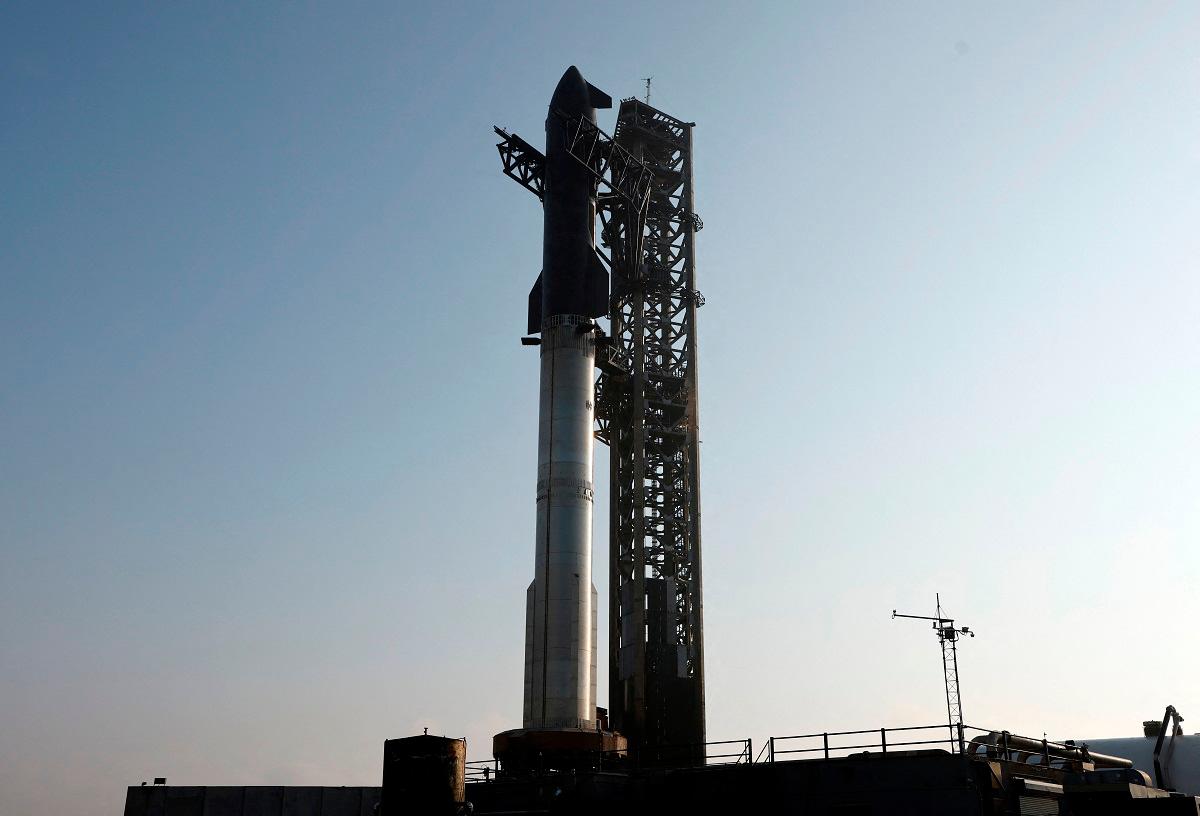STARBASE: Starship, the futuristic SpaceX rocket vehicle on which Elon Musk’s ambitions for multiplanetary travel are riding, roared into the sky from Texas on Tuesday on its ninth uncrewed test launch, aiming for a clean flight after the last two attempts ended in explosive failure.
The two-stage spacecraft, consisting of the Starship vessel mounted atop a towering SpaceX Super Heavy rocket booster, blasted off at about 7:36 p.m. EDT (2330 GMT) from the company’s Starbase launch site on the Gulf Coast of Texas near Brownsville.
A live SpaceX webcast of the liftoff showed the rocketship rising from the launch tower into the early evening sky as the Super Heavy’s cluster of powerful Raptor engines thundered to life in a ball of flame and billowing clouds of exhaust and water vapor.
SpaceX launched the Starship system with a previously flown Super Heavy booster for the first time, aiming to achieve a key demonstration of its reusability. The 232-foot (71-m) first-stage booster will not attempt a return to its launch pad but target the Gulf of Mexico for a controlled splashdown.
Federal regulators granted SpaceX a license for Starship’s latest flight attempt just four days ago, capping a mishap investigation that had grounded Starship for nearly two months.
Its last two test flights - in January and March - were cut short moments after liftoff as the vehicle blew to pieces on its ascent, raining debris over parts of the Caribbean and disrupting scores of commercial airline flights in the region.
The Federal Aviation Administration expanded debris hazard zones around the ascent path for Tuesday’s launch, the ninth full test flight of the Starship campaign.
The previous back-to-back failures occurred in early test-flight phases that SpaceX had easily achieved before, dealing a striking setback to a program that Musk, the billionaire entrepreneur who founded the rocket company in 2002, had sought to accelerate this year.
Musk, the world’s wealthiest individual and a key supporter of U.S. President Donald Trump, was especially eager for a success after vowing in recent days to refocus his attention on his various business ventures, including SpaceX, following a tumultuous foray into national politics and his attempts at cutting government bureaucracy.
Musk is counting on Starship to fulfill his goal of producing a large, multipurpose next-generation spacecraft capable of sending people and cargo to the moon later this decade and ultimately flying to Mars.
Closer to home, Musk also sees Starship as eventually replacing the SpaceX Falcon 9 rocket as the workhorse in the company’s commercial launch business, which already lofts most of the world’s satellites and other payloads to low-Earth orbit.
Musk was scheduled to deliver an update on his space exploration ambitions in a speech from Starbase following the test flight, to be livestreamed under the banner slogan “The Road to Making Life Multiplanetary.”
He was expected to offer new timelines and development plans for sending cargo and potentially astronauts aboard Starship on voyages to Mars, a tantalizing but still-distant future destination for human spaceflight that poses major technical hurdles for SpaceX and NASA.
The speech could also offer clues about the trajectory of NASA’s human spaceflight strategy. While Musk has been known to make overly ambitious projections about SpaceX’s development timelines, he has since amassed significantly more sway over the Trump administration’s space agenda.
The 400-foot-tall (122 m) Starship rocket system is the centerpiece of Musk’s vision to ferry humans to Mars and expand SpaceX’s global dominance in the satellite launch market, a foothold the company gained with its reusable Falcon 9.
Picked by NASA in 2021 as the vehicle to return humans to the moon’s surface this decade for the first time in more than 50 years, Starship is expected to play an even bigger role in the U.S. space program. Trump attended a Starship test launch in November and has publicly promoted Musk’s Mars vision.
Musk and SpaceX remain influential over U.S. space policy despite his recent shift away from government and signals to cut political spending.
Trump’s choice to lead NASA, Jared Isaacman, a billionaire private astronaut and SpaceX customer for whom Musk advocated, testified before a U.S. Senate committee in April but has not advanced through the full confirmation process, while significant changes loom at the U.S. space agency.
A White House budget blueprint released earlier this month proposed $6 billion in cuts at NASA, bolstering the agency’s Mars focus and threatening programs that Musk and Isaacman have criticized.
During a tense May 22 White House event with Trump and South African President Cyril Ramaphosa, South African-born Musk stood among Trump’s cabinet officials in the room and was pointed out by the U.S. president.
“He actually came here on a different subject: sending rockets to Mars,“ Trump said. “He likes that subject better.”









